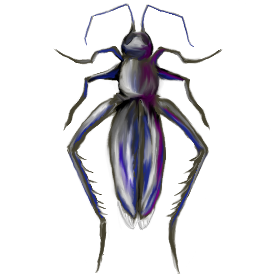From Wikimalia
| The Bug Collection
|
|
|
|
|
| Keke Cricket
|
| Habitat: | Temperate forests, dark reclusive areas.
|
| Description: | Glossy blue-black, the carapace of this cricket is highly refractive, and depending upon light intensity, may appear as any color from jet black to sea green. Specimens rarely exceed a thum and a half in length, if one discounts the half-thum-long elbow-jointed antennae just above the eyes. The rear segment of the carapace is divided, barely exposing the rigid wingtips. The underside is less glossy, and much lighter in color, and females are slightly smaller and lighter than the males.
|
| Notes: | Nocturnal, the keke cricket's life, like most insects, is a cornucopia of feeding and mating. A two-to-one ratio of males to females insures a very high level of male competition, and this competition is won by the male's mating call in sheer volume. 'Keke-Keke', is a sound heard in virtually every corner of the world. Males can generate a very loud call, easily capable of being heard for several hundred yards, amplified in closed spaces. Fortunately for humanoid ears, but unfortunate for the loudest of the crickets, it is also a dinner bell for their natural predators, namely mice, voles, rats and lizards. Their other earless predators enjoy the proliferation of males as well, although they must rely on other methods to locate the prey. Surprisingly, males of the species will sacrifice themselves to protect a female, a behavior rarely seen in the insect kingdom. Larger males are able to dismantle smaller spider webs with their powerful rear legs, and some have even been observed -attacking- a praying mantis.
|
|
While the pleasantness of the male's mating call is a matter of personal opinion, few would dispute that enough crickets in a house can drive the occupants mad with the volume of sound, which has been noted to attract additional unwanted household pests and vermin. They are not, however, responsible for the malady known as 'keke sickness', in which afflicted humanoids are known to chirp 'keke' involuntarily for hours on end. There are no known cases of recovery from this sickness, although the cricket is not to blame.
This article is a stub. You can help Wikimalia by expanding it.
Back to the Insect/Arachnid page.

